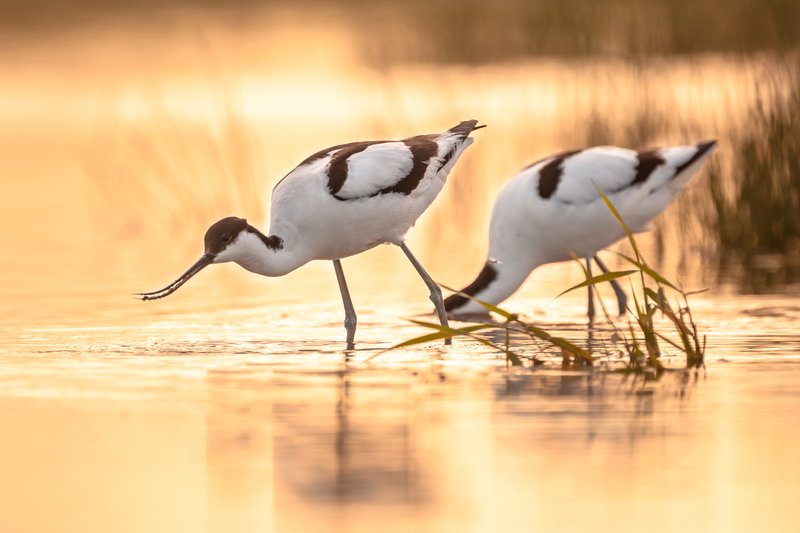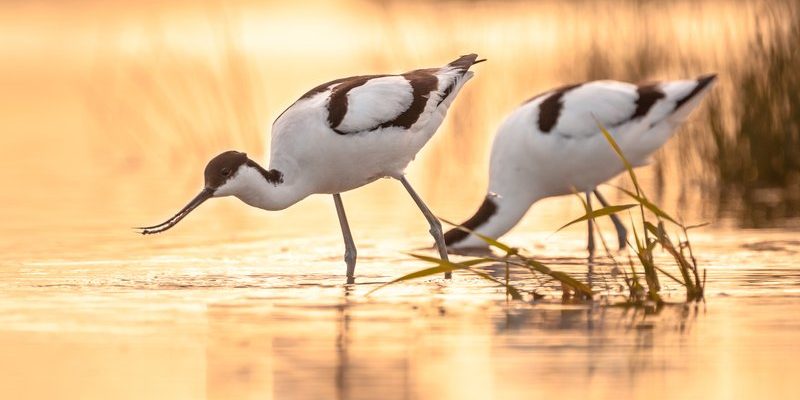
Imagine standing by the water’s edge, watching a bird with strikingly long legs and a gracefully curved beak. That’s the Avocet for you! These wading birds are known for their stunning appearance and unique feeding habits. With their distinctive traits, they capture the attention of birdwatchers and nature enthusiasts alike. Avocets belong to the family Recurvirostridae, which also includes other shorebirds like the stilts.
Avocets are most commonly found in wetlands, marshes, and coastal areas around the world. They have a reputation for their elegant movement and striking contrast in color. From their black-and-white plumage to their graceful stance, these birds are truly a sight to behold. Whether they’re sweeping their crescent-shaped bills through the water or wading through shallow wetlands, they embody the beauty of nature.
Physical Characteristics
Avocets are practically fashion icons of the bird world. Their long, thin legs allow them to wade gracefully through water, while their distinctive upturned bills serve a unique purpose. This specially shaped bill enables them to forage in the mud and sand for small invertebrates and crustaceans. Depending on the species, Avocets can range in size from about 14 to 20 inches long, with a wingspan that reaches nearly 30 inches.
There are several species of Avocets, including the American Avocet and the Eurasian Avocet, each with slight variations in appearance. For example, the American Avocet features a striking rusty hue during breeding season that adds to its visual allure. Their plumage can change dramatically from season to season, making them even more interesting to observe.
A table summarizing key physical characteristics of Avocets can give you a quick overview:
| Species | Size (Length) | Wingspan | Coloration |
| American Avocet | 18-20 inches | 28-30 inches | Black, white, & rusty during breeding |
| Eurasian Avocet | 14-18 inches | 28-30 inches | Black, white, & grayish |
Habitat and Distribution
Avocets are widely distributed across several continents, including North America, Europe, and Asia. They tend to prefer shallow coastal waters, estuaries, and freshwater wetlands. You might find them on mudflats or sandy shores, where they can easily probe the soft substrate for food. Their habitat choices are closely linked to breeding and feeding cycles which can change with the seasons.
During migration, Avocets travel in groups, often seen flying in a graceful formation. Their migratory routes typically follow coastal regions and wetlands, ensuring they always have access to the food sources necessary for their survival. In winter, many Avocets will head to warmer climates where food is more abundant and water sources don’t freeze over.
Interestingly, the types of habitats Avocets choose can also affect their behavior. They are social birds, often seen foraging and roosting together in large flocks, which can be quite a sight! This social structure provides safety in numbers and enhances their ability to find food.
Feeding Habits
You might be curious about how these elegant birds find their dinner. Avocets primarily feed on small aquatic invertebrates like insects, crustaceans, and mollusks. Their unique upturned bills allow them to sweep through the shallow waters and mudflats, sifting for food. This feeding technique is quite fascinating; they often skim the surface or probe into the sand, turning up a hidden treasure of tasty morsels.
During the breeding season, when they are more active, their diet can shift slightly. They may focus on areas with abundant food sources to support their energy needs while caring for their young. The availability of food can significantly impact their breeding success, making their feeding habits all the more critical.
It’s also interesting to note that in times of food scarcity, Avocets are known to change their foraging techniques. They might switch from searching for invertebrates to seeking out plant matter or even altering their feeding times to adapt to environmental changes. This flexibility is key to their survival in diverse habitats.
Breeding and Nesting
When it comes to breeding, Avocets have some unique practices. They typically nest in colonies, which provides safety for their eggs and chicks. Nesting sites are often located in shallow depressions in the ground, close to water sources. The nests are usually unlined, which means the eggs are laid directly on the substrate. Avocets usually lay a clutch of 3-4 eggs, which are beautifully speckled and blend in with the surrounding environment.
The parents take turns incubating the eggs for about 21 to 25 days. During this time, they are protective and vigilant, warding off potential threats. Once the chicks hatch, they are precocial, meaning they can walk and forage for themselves almost immediately. However, they still rely on their parents for protection and guidance as they learn the ropes of foraging.
Interestingly, Avocets often display strong parental instincts. They will fiercely defend their territory against intruders, making it a fascinating spectacle to witness. The bond between them and their young is essential for ensuring the survival of the next generation.
Conservation Status
Avocets have seen a mixed bag of conservation status across different regions. While some populations are stable, others face threats from habitat loss, pollution, and human activities. Wetland degradation is one of the significant challenges they face, as it reduces the quality and availability of their natural habitats.
Conservation efforts are vital to ensure the survival of these stunning birds. Habitat restoration projects and wetland preservation initiatives play a crucial role in maintaining the ecosystems that avocets rely on. Engaging local communities in conservation can also contribute positively, as it raises awareness and promotes actions that protect these beautiful birds.
Birdwatching organizations and conservation groups often host events to encourage people to observe Avocets and learn more about their habitats. By fostering a greater understanding of these birds, we can inspire future generations to protect them and their environments.
FAQ
What do Avocets look like?
Avocets have long, spindly legs and a unique upturned bill that sets them apart from other shorebirds. Their plumage can vary by species, but many have striking black and white colors, with the American Avocet displaying a beautiful rusty hue during the breeding season.
Where can I find Avocets?
Avocets inhabit shallow coastal waters, estuaries, and wetlands around the world. Depending on the season, you can find them migrating along coastlines or nesting near freshwater sources. They tend to prefer areas with plenty of food options, like mudflats and marshes.
What do Avocets eat?
These birds primarily feed on small aquatic invertebrates such as insects and crustaceans. They use their upturned bills to skim the surface of the water or probe into the mud to find food. Their diet may also shift based on seasonal availability.
Are Avocets social birds?
Yes, Avocets are quite social and often seen foraging and nesting in groups. This social structure helps provide protection against predators and increases their chances of finding food in their habitats.
How do Avocets reproduce?
Avocets typically nest in colonies. They lay 3-4 eggs in shallow depressions close to water, and both parents participate in incubation. After hatching, the chicks are precocial, meaning they can walk and forage for themselves, although they still rely on their parents for protection.
What threats do Avocets face?
Avocets face various threats, including habitat loss due to wetland degradation, pollution, and human activities. These challenges can impact their breeding success and overall population stability, making conservation efforts essential.
How can I help protect Avocets?
You can help protect Avocets by supporting local conservation efforts, participating in clean-up events in wetland areas, and spreading awareness about their importance. Engaging in responsible birdwatching practices can also ensure that these beautiful creatures are respected in their natural habitats.
Can Avocets fly long distances?
Yes, Avocets can migrate long distances, often traveling in groups. Their migratory routes typically follow coastal areas and wetlands, selecting locations with ample food sources and suitable breeding grounds.
What is the lifespan of an Avocet?
The lifespan of an Avocet varies, but in the wild, they can live up to 10 years or more. Various factors such as habitat quality, food availability, and predation pressures can influence their overall lifespan.
Are Avocets endangered?
While Avocets are not currently classified as endangered, certain populations are at risk due to habitat degradation and environmental changes. Conservation measures are crucial for ensuring their continued survival and stability.

